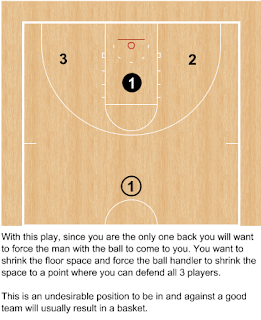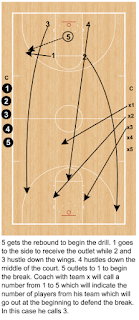Man to Man Defensive Principles: Defensive Transition
Over the last year we have written many posts related to man to man defensive principles and all of them are important. One of the most important defensive principles is also one of the most overlooked. The specific principle I'm talking about is defensive transition.
Before we get into details, let's make sure that we understand what defensive transition means. To start with let's go to the offensive end of the floor and talk about the fast break. Every basketball fan loves the fast break because of it's speed and flair. Every coach loves the fast break because of it's ability to create scoring chances for your team when the defense is in a vulnerable position. It is this vulnerable position and how to defend against teams that want to take advantage of it that we want to discuss in this post.
When your team plays a zone it is a lot easier to play transition defense that when you are playing man to man. When in a zone the coach simply has to instruct his players to go to their respective spots on the floor as quickly as possible and the team is good to go (Okay, it's a bit more complicated than that, regardless of whether your team is in a zone or man you still have stop the ball and determine if it's better to let the ball come to you or stop the ball further up the floor but at least you don't have to spend time looking for your man).
What we're going to cover here are some principles to defensive transition when playing man to man that need to be drilled by every coach whose team plays this defense. Many of these principles can be applied when your team is playing a zone as well.
Defensive Transition Principles
Before we get into details, let's make sure that we understand what defensive transition means. To start with let's go to the offensive end of the floor and talk about the fast break. Every basketball fan loves the fast break because of it's speed and flair. Every coach loves the fast break because of it's ability to create scoring chances for your team when the defense is in a vulnerable position. It is this vulnerable position and how to defend against teams that want to take advantage of it that we want to discuss in this post.
When your team plays a zone it is a lot easier to play transition defense that when you are playing man to man. When in a zone the coach simply has to instruct his players to go to their respective spots on the floor as quickly as possible and the team is good to go (Okay, it's a bit more complicated than that, regardless of whether your team is in a zone or man you still have stop the ball and determine if it's better to let the ball come to you or stop the ball further up the floor but at least you don't have to spend time looking for your man).
What we're going to cover here are some principles to defensive transition when playing man to man that need to be drilled by every coach whose team plays this defense. Many of these principles can be applied when your team is playing a zone as well.
Defensive Transition Principles
- Look to see if there is a player close to the basket you are defending - even without the ball, this is the most dangerous man on the floor. If there is a man open close to the basket you need to get back and try to cover him before the man with the ball spots him. This rule applies even if this player is not your man.
- Find the player who has the ball - the second most important player on the floor during defensive transition is the player with the ball. Regardless of whether this is your player or not this man needs to be covered and harassed quickly. Be aggressive when covering this player. Your job is to slow him down enough to have your teammates get back and help you stop the break.
- Communication - talking to your teammates is important when in defensive transition. You need to stop the player with the ball and cover the players closest to the basket but you don't want more the one player doing the job. This is why coaches should preach communication. Instruct players to call out who's going to get the ball, who they are covering, and who should cover players. In general, I like to have the player closet to our basket at a given time do a lot of the instructing since he has the whole play in front of him.
- Get back as quickly as possible - the time for rest is not when you're playing defense. You need to hustle back as quickly as possible.
- Find your man - one of the biggest differences between a man to man and zone is what players need to do when transitioning from offense to defense. When you are playing man to man you need to find your man as quickly as possible. Keep in mind that even when you do locate your player, if he is not the closest man to the basket or the man with the ball, and both of these players are unmarked you will need to hold off on covering your player until these 2 players are covered by someone. If there isn't another teammate around to cover these 2 players you will need to cover them.
- You are not tied to one player - in transition you will be forced to cover someone other than the player you have been assigned to. This is normal. Don't bail out on stopping the ball or covering the player closest to the basket simply because they are not the man you have been assigned to.
- Only pick up your player closely if he is below the ball - if your player is above the ball (close to half court while ball is closer to the basket) get back and help your teammates. Keep an eye on your player but he isn't in a threatening position.
- The goal when playing transition defense is to do one of the following (in order of preference):
- Stop the break.
- Stall until your teammates can recover and get back to play defense.
- Force the other team into a shot as far from the basket as possible.
- 3v1 (applies to all situations that have only one man defending the basket).
- 3v2
- 4v3
There you have it. Transition defense is not glamorous but it is so important. Many times a close game can be decided by which team gets more easy shots. By practicing transition defense you will have your team understand how to defend against easy shots. In future posts we will show you some nice drills to include in practice that can help your team get used to defending the fast break.








Comments
Post a Comment